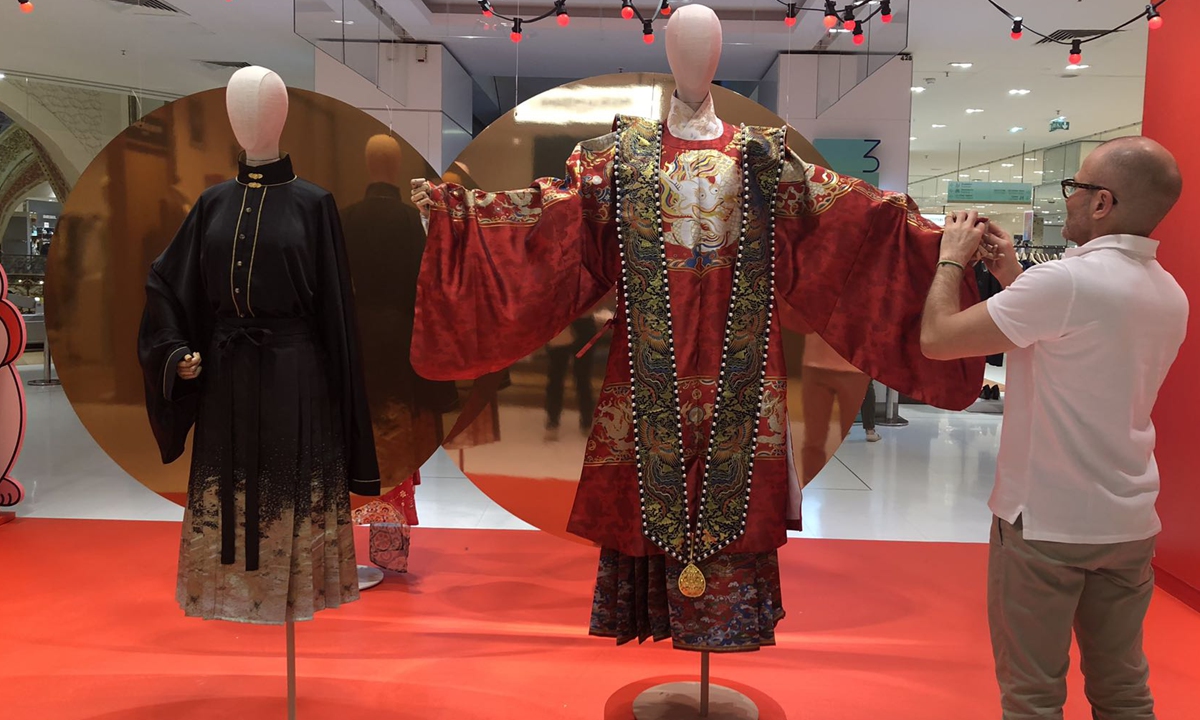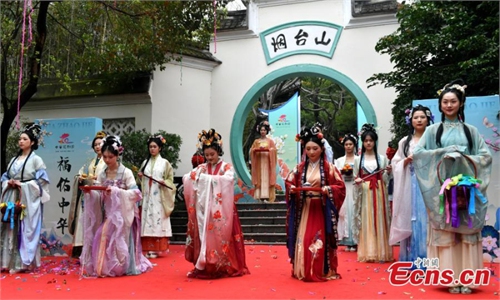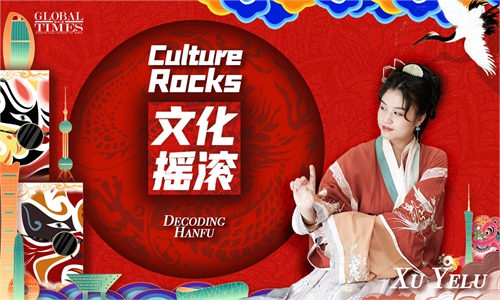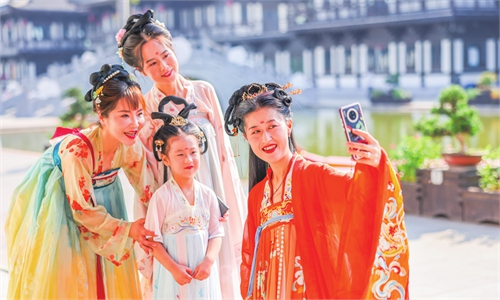ARTS / CULTURE & LEISURE
Exclusive: Overseas Chinese students promote hanfu, mamianqun in Paris exhibition
For our roots

A man takes photos during a hanfu exhibition in Paris, France. Photo: Courtesy of Liu Jing
It was a big day for Liu Jing, an overseas Chinese student in Paris. She has been working with her friends for three months on an exhibition, which opened on Thursday, to promote hanfu - traditional Chinese attire - including mamianqun (horse-face skirt), as their latest efforts to raise the world's public awareness of Chinese culture.
"It's been a while since we promoted traditional Chinese culture as an organization in Paris. And I think this is a great chance as this exhibition kicks off at the center of Galeries Lafayette, which sees massive foot traffic every day," said Liu.
Liu, a computer-science major in France who has been dedicated to promoting Chinese culture and a lover of hanfu, has established the Mugua Organization, a nongovernmental traditional Chinese cultural organization in France.
"I established the organization to unite more people and promote Chinese culture together, and they are Chinese moms, locals who are in love with traditional Chinese culture, and overseas students as well," she noted.
The four most representative women's clothing from different dynasties of China are on display in the most conspicuous position, where delicate gold-edged decorations glisten under the lights.
Liu and her team came up with the idea deciding to choose the most representative clothes including qixiong ruqun, a typical chest-high Chinese skirt in Tang Dynasty (618-907), the wedding dress in Ming Dynasty (1368-1644), songbeizi, a popular long outer coat with loose and long sleeves in Song Dynasty (960-1279), and a modern style mamianqun.
"We were doing a traditional Chinese cultural event when an employee from Galeries Lafayette stepped up to us asking whether we were interested in organizing an exhibition with them," said Liu.
In mid 2022, the French brand Dior introduced its new collection by using China's traditional mamianqun element without acknowledging it.
The French luxury brand was criticized due to the incident. The controversy spread not only on Chinese social media platform Sina Weibo, but also among Chinese nationals around the world, where a series of activities erupted among people to speak up and defend Chinese culture.
"The negative impact of the Dior incident has obviously stressed the importance of recognizing Chinese culture on the international stage. It is an exciting thing for more and more Chinese groups and individuals to tell others about our own culture," Tan Shan, a Beijing-based cultural expert and sociologist, told the Global Times on Thursday.
"People defend their culture when it is misunderstood or twisted, and only through these actions can we have a better cultural exchanges between China and the rest of the world."
Long and huge duty
Among the countless clothing elements in the Ming Dynasty, the horse-face skirt was one of the most popular skirts during that time, which was designed with two pieces of wrinkled cloth on the side and two other pieces of smooth cloth at the front and the back.
"The popularity of mamianqun at the time is also a reflection of traditional Chinese etiquette, which met the aesthetic needs of Chinese people," noted Cao Zhe, an associate professor of Nantong University.
"From a wider perspective, all the elements hidden in hanfu are manifestations of our own culture, reflecting our spiritual world."
Ao Luojia, a hanfu designer and internet influencer specializing in traditional Chinese culture based in Southwest China's Chongqing Municipality, told the Global Times on Thursday that she really admires the passion and determination of those overseas Chinese students, adding that there was still a long way to go.
"We need more people, products and brands to show China's profound culture and traditional craftsmanship. Otherwise, the significance of the campaign will be greatly weakened," she said.
Ao believes that, in the near future, the elements and craftsmanship of Chinese traditional costume will appear not only in the daily boutique, but also in the low-key luxury dress brand and haute couture.
"This kind of cultural renaissance reflects out boost confidence to traditional Chinese culture. We need to cherish and inherit our own culture, develop and innovate it, and stand out for promoting it. This is what we [traditional Chinese cultural promoters] are always striving for," Ao said.



